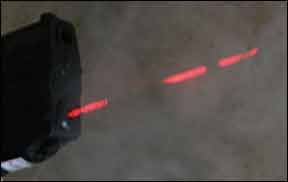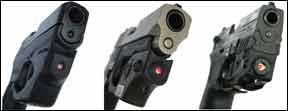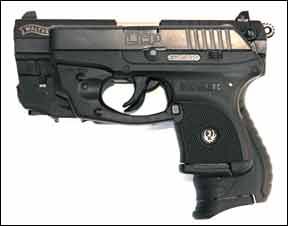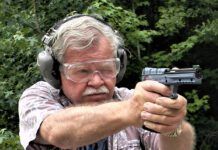Lasersights on handguns are common today. Scan the used-handgun case at a gun shop, and more than likely youll find a rig that the former owner customized with a laser sight. In the new-pistol case, you will also see factory-fitted laser sights on handguns. We were interested in how factory-fitted lasersights would affect our judgment of three previously tested 380 ACP pistols, the Ruger LCP, SIGs P238, and Walthers PK380. The Ruger earned an A- grade in the June 2008, and the SIG notched an A- in the June 2010 issue, and the Walther got a B-, also in the June 2010 issue. The lasered versions of those handguns are the Ruger LCP-LM No. 3718 380 ACP, $443; SIG Sauers P238 Tactical Laser No. 238-380-TL 380 ACP, $829; and Walthers PK380 With Laser No. WAP40010 380 ACP, $489. Would the addition of a laser sight change our mind about the pistol? Would the addition of a laser bulk up a pocket pistol with a gadget? Would the laser be an asset or a detriment to an already fine pistol? The three pistols spanned the spectrum of action types.

The Ruger is a DAO (Double Action Only). The Walther PK380 is a traditional DA/SA (Double Action/Single Action) pistol, where the pistol can be fired DA and subsequently fired SA. The SIG, SA only, was set up like a mini 1911. These pistols are made for close work, so we tested for accuracy at 15 yards with open sights, but were more interested in using the lasers in unconventional shooting positions, much like you might encounter in a real-life confrontation with a bad actor. Our goal with these lasered pocket pistols was to quickly project the red dot on target and punch holes in targets efficiently and effectively. We used D-1 tombstone-style targets with a 4-inch-diameter X-ring and an A-ring and B-ring at 8 inches and 12 inches, respectively. The rings are visible at close range – about 5 yards, but beyond that and depending on your eye sight, the rings are undetectable.
All three employed red Class IIIa lasers. The warning label was blatantly affixed to each laser. Dont point the laser beam in eyes, as permanent eye damage can result. (Never mind the damage from a 380 slug.) Laser beams can reflect off certain surfaces like TV screens, mirrors, glass, etc. Make sure you test the laser of an unloaded weapon so you can experience how the laser beam can react. Also note that laser sights should also be removed when cleaning the weapon, as oils and solvents are not good for the lasers electronics.
As in any test, we focused on the major areas of importance with these pistols, such as reliability, concealability, shooter comfort, and accuracy. But because of the lasers, we zeroed in on how the optics affected handling, printing, and other carry issues.
Walther PK380 With Laser No. WAP40010 380 ACP, $489
Where the Ruger and P238 were sleek looking, the Walther was aggressive and edgy. The Walther PK380 was much larger than the Ruger and the SIG. Similar to the SIG, it has sharper edges, and the iron sights snagged on pant pockets. The PK380 was definitely a holster pistol, we thought.

Many testers liked shooting the PK380. The grip felt good in the hand, they said. The small finger rest on the magazine floorplate allowed shooters with big hands to comfortably hold the gun. Like the SIG, the Walthers slide was easy to manipulate, and the slide stayed open on the last shot. The double-action trigger was clean like the Rugers, and the single-action pull was not as good as the SIGs, our testers said. Those unaccustomed to DA/SA triggers at first felt the trigger was malfunctioning, but that is a training hurdle with these types of pistols and is by no means a negative. Shooters with both the Ruger and Walther, because of the DA trigger, were able to aim the red dot and watch the red dot twitch as they followed through with their trigger pulls. In anticipation of the gun firing, some shooters saw the red dot twitch off center, indicating a flinch that needed to be corrected. The recoil was soft with no muzzle flip.
The PK380 was easy for testers to control, and like the other pistols, was fired without the use of iron sights, though in bright light there was the need to have sights to find the red dot. The laser needed to be adjusted to align with the iron sights, and that was accomplished via a small screwdriver supplied by Walther. The laser easily and quickly could be attached and removed from the pistol by pulling down on tabs on either side of the sight and sliding it forward and off the rail.
The laser was turned on via a sliding switch that was hard to reach and manipulate for some shooters. Only right-handed shooters could turn on the laser with their shooting fingers. A nice feature of the Walther was a pair of tiny red lights that faced the user. These lights were lit when the laser was activated and that was comforting to many users who at times, especially in bright light, did not know it the laser was activated.
Our Team Said: The Walther was fun to shoot, and our shooters liked that the laser could be removed and re-attached with no readjusting of the sights. A major downside was that the Walther was bigger than the Ruger and was not as easily concealed.
Ruger LCP-LM No. 3718 380 ACP, $443
The LCP-LM mashed together Rugers tiniest pistol with LaserMaxs trigger-guard laser sight. The laser was nicely integrated into the pistol, similar to the SIG P238. Some thought the Ruger did a better job integrating the laser to the pistol. The trigger was nice and broke cleanly, but the female tester in the group had a hard time racking the slide. As pistols get smaller they can be harder to use and operate. Big-mitt testers felt the Ruger was the hardest of the three to fire easily. The trade off with the Rugers smaller size was slightly less accuracy and control. However, all testers felt they would be able to shoot the Ruger better with more practice. Another point that testers did not like was the laser-activation button. To turn the laser on, the button was pressed from either the right or left side. To turn it off, the shooter pressed the button from the opposite side to center the button. You could not turn the laser on and off using one hand.

The laser battery was accessed via screws and that allow a sideplate to be removed. One 1/3 N-cell lithium battery powered the laser. The laser could be removed from the LCP, but there were polymer tabs that look like they could easily be broken if the laser was snapped on and off the gun numerous times. The LCP-LM was adjusted via two tiny hex screws. The Ruger has minimal sights that allowed the pistol to slip easily into most any size pocket, though if your girlfriend is carrying the tiny Ruger, it would imprint if she was wearing her skinny jeans. The LCP-LM was the only pistol that could easily hide in a pant pocket. There are no controls protruding out of the pistol, so it was very smooth. A manual slide stop is embedded into the LCP-LM and can be used to manually hold the slide open. The slide did not stay open after the last round was fired. The Ruger had more pronounced muzzle flip, making follow-up shots not as precise but still within the rings of the D-1 target. More seasoned testers did not like that the slide did not lock open on the last shot, like it did with the SIG and Walther.
Our Team Said: The Ruger was the best choice for deep-conceal carry, we believe. But we noted some dings on it: The laser needed two hands to be turned on and off, and it had some muzzle flip. Still, the small package was controllable enough and affordable enough to come in above the others, in our opinion.
SIG Sauer P238 Tactical Laser No. 238-380-TL 380 ACP, $829
The SIG Sauer P238 felt very familiar to those testers accustomed to the 1911 platform. Though the P238 mimics the 1911 controls – slide stop, thumb safety, magazine release, SA trigger, and exposed hammer – the mechanism is quite different than a 1911. Most shooters felt this pistol was easiest to shoot well because of the SA trigger. The open sights were large and looked almost like sights on a full-size 1911. But because of the sights, the P238 needs to be carried in a holster or the large pocket of an overcoat.
The laser for the P238 was nicely integrated on the P238s frame/receiver under the barrel and around the trigger guard. The laser lens was almost flush with the muzzle of the gun, which means it will need to be cleaned after training sessions as soot could build up. The laser lenses for the LCP-LM and PK380 were slightly rearward of the muzzle, but nevertheless close enough to mean they would need maintenance, too.
The SIGs laser added but 1 ounce to the overall weight. It features an ambidextrous on/off button. The laser could be activated and deactivated easily with either shooting hand. The button was protected by a ridge that protruded above the button, but the button could easily be turned on by pressing it through the thin fabric of pant pocket. It could accidently turn on if bumped just right, but this can be said of all the laser sights.
It used one 3V CR1/3N lithium battery that was accessible by removing two larger hex screws and removing the left sideplate of the laser sight. The sight could also be removed from the pistol at this point as well.
From the factory, the laser did not need adjustment. At 15 yards the open sights and laser were in sync. Windage and elevation adjustments could be made via two adjustment screws that used a tiny hex wrench. Press either button on either side of the laser once and the laser stayed on. Press either button once to turn it off.
During firing, it was easy for testers to hit the rings of the D-1 target only using the laser. In bright light, all three lasers were hard to detect, so a rig that has the iron sights aligned with the laser sight is a must as the sights in bright light helped shooters find the red dot on the target. The P238s sights were large and easy to pick up. The slightly longer grip made the SIG and the Walther easier to control than the Ruger, in our estimation. The SIG, if carried cocked-and-locked, was quick to get into action, but if the hammer needed to be thumbed back, you lost precious moments that neither the Ruger nor the Walther gave up.
Our Team Said: They liked the trigger best out of all three, but thought the SIG was too bulky and the open sights snagged when some testers tried to slip the P238 into their pants pocket. They liked how this laser was activated the best.
Written and photographed by Robert A. Sadowski, using evaluations from Gun Tests team testers. GT
0213-POCKET-PISTOLS-ACC-CHRONO-DATA.pdf



























Hi it’s me, I am also visiting this website
daily, this site is really good and the people are genuinely
sharing good thoughts.